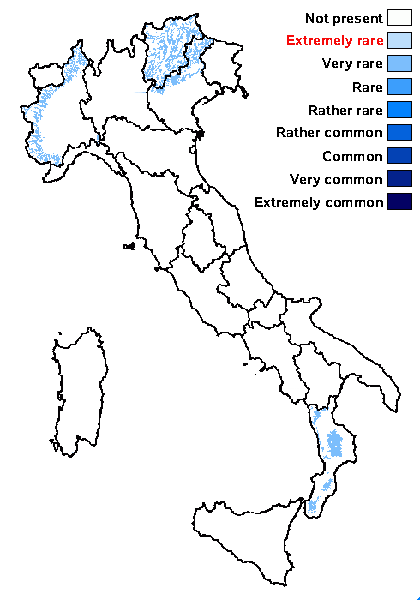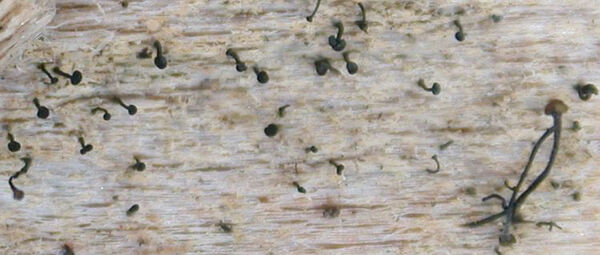Chaenothecopsis pusiola (Ach.) Vain.
Acta Soc. Fauna Fl. Fenn., 57, 1: 70, 1927. Basionym: Calicium pusiolum Ach. - K. Sv. Vetensk.-Acad. Handl.: 231, 1817.
Synonyms: Calicium lignicolum Nádv.; Chaenothecopsis lignicola (Nádv.) A.F.W. Schmidt; Coniocybe nigricans Fr.
Distribution: N - Ven (Nascimbene 2008c, Brackel 2016), TAA (Brackel 2016), Piem (Isocrono & al. 2004, Puntillo & Puntillo 2009, Brackel 2016). S - Cal (Puntillo 1994, 1996, Puntillo & Puntillo 2009, Brackel & Puntillo 2016, Brackel 2016).
Description: Thallus not evident, not lichenized. Apothecia stalked, pin-like. 0.3-0.5 mm high, the stalk 0.04-0.1 mm thick, black or rarely brown in lower part, the central part hyaline, formed by periclinally arranged hyphae, the outer part formed by irregularly intertwined, medium brown hyphae. Capitulum lenticular to hemispherical, 0.15-0.22 mm across, black; mazaedium absent. Exciple well-developed, of dark brown, periclinally arranged hyphae; epithecium thin, brownish; hypothecium 55-65 µm high, colourless to yellowish brown. Asci 8-spored, cylindrical, with a thickened apex penetrated by a narrow canal, formed singly, persisting until the spores are mature. Ascospores 1-septate, pale brown, ellipsoid, 5.5-7 x 2-2.5 µm, with a poorly pigmented, thin septum and a smooth wall. Photobiont absent. Spot tests: all brown or reddish pigmented parts K+ red, the reaction rapidly fading and the tissue turning greenish brown. Chemistry: an undidentified reddish pigment.Note: on lignum of conifers, more rarely of deciduous trees in the upper montane and subalpine belts, most often associated with Chaenotheca brunneola, Ch. trichialis and Ch. xyloxena, and probably a parasite or parasymbiont of these species; certainly more widespread, but not common, in the Alps, also known from Calabria.
Growth form: Lichenicolous fungus
Substrata: bark and lignum
Reproductive strategy: mainly sexual
In underhangs rarely wetted by rain
paras Chaenotheca spp.
Commonnes-rarity: (info)
Alpine belt: absent
Subalpine belt: absent
Oromediterranean belt: absent
Montane belt: very rare
Submediterranean belt: absent
Padanian area: absent
Humid submediterranean belt: absent
Humid mediterranean belt: absent
Dry mediterranean belt: absent

Predictive model
Herbarium samples
Growth form: Lichenicolous fungus
Substrata: bark and lignum
Reproductive strategy: mainly sexual
In underhangs rarely wetted by rain
paras Chaenotheca spp.
Commonnes-rarity: (info)
Alpine belt: absent
Subalpine belt: absent
Oromediterranean belt: absent
Montane belt: very rare
Submediterranean belt: absent
Padanian area: absent
Humid submediterranean belt: absent
Humid mediterranean belt: absent
Dry mediterranean belt: absent

Predictive model
| Herbarium samples |
 Index Fungorum
Index Fungorum
 GBIF
GBIF


